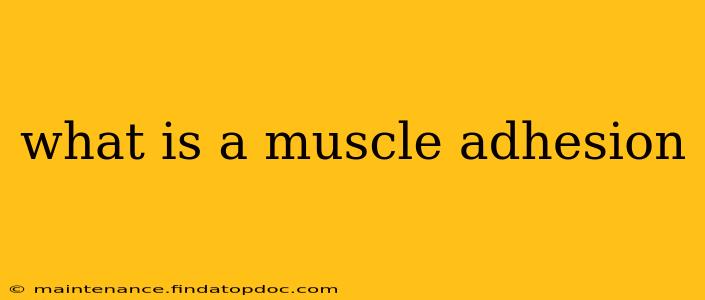Muscle adhesions are essentially sticky bands of scar tissue that form between muscle fibers. These adhesions restrict the muscle's normal movement and function, often leading to pain, stiffness, and limited range of motion. Think of it like Velcro clinging to itself – the muscle fibers, instead of sliding smoothly past each other during movement, are stuck together. This prevents the muscle from contracting and relaxing efficiently.
Understanding muscle adhesions is crucial for anyone experiencing chronic muscle pain or stiffness. They aren't always readily apparent, but their impact can be significant.
What Causes Muscle Adhesions?
Several factors can contribute to the formation of muscle adhesions:
-
Muscle Injuries: Tears or strains in the muscle tissue can trigger the body's natural healing process, which involves the formation of scar tissue. This scar tissue can sometimes form adhesions, binding muscle fibers together.
-
Repetitive Strain Injuries: Repeatedly using a muscle in the same way (e.g., typing, lifting heavy objects) can lead to micro-tears and inflammation, ultimately resulting in adhesion formation.
-
Poor Posture: Maintaining poor posture for extended periods can create tension and strain in certain muscle groups, increasing the likelihood of adhesions.
-
Lack of Movement: A sedentary lifestyle can contribute to muscle stiffness and tightness, making the formation of adhesions more probable.
-
Dehydration: Dehydrated muscles are more prone to injury and less efficient at self-repair, increasing the risk of adhesion development.
-
Inflammatory Conditions: Conditions like fibromyalgia or autoimmune diseases can also cause inflammation that may contribute to adhesion formation.
How Do Muscle Adhesions Feel?
Recognizing the symptoms of muscle adhesions is crucial for timely intervention. Common sensations include:
-
Localized Pain: A sharp, stabbing, or aching pain often concentrated in a specific area.
-
Muscle Tightness: A feeling of stiffness or restricted movement in the affected muscle.
-
Limited Range of Motion: Difficulty moving the affected joint or muscle through its full range of motion.
-
Muscle Knots (Trigger Points): These are small, hard nodules within the muscle that are often exquisitely tender to the touch.
How Are Muscle Adhesions Diagnosed?
Diagnosing muscle adhesions can be challenging as there isn't a single definitive test. Diagnosis often relies on a combination of:
-
Physical Examination: A healthcare professional will assess your range of motion, palpate (feel) your muscles for knots or areas of tightness, and inquire about your symptoms.
-
Medical History: A thorough medical history, including information about injuries, lifestyle, and existing conditions, is essential.
-
Imaging Techniques: While not always necessary, imaging tests such as ultrasound or MRI may be used to visualize muscle tissue and identify potential adhesions in some cases.
How Are Muscle Adhesions Treated?
Fortunately, several effective treatments can help to break down muscle adhesions and restore normal muscle function. These may include:
-
Massage Therapy: Various massage techniques, such as deep tissue massage, can help to break up adhesions and improve blood flow.
-
Myofascial Release: A specialized type of massage therapy that focuses on releasing tension in the fascia (the connective tissue that surrounds muscles).
-
Stretching: Regular stretching exercises can help to lengthen muscles and improve flexibility, preventing adhesion formation and reducing existing ones.
-
Foam Rolling: Self-massage using a foam roller can target specific muscle groups and help to release tension.
-
Dry Needling: This technique involves inserting thin needles into trigger points to release muscle tension.
-
Exercise Therapy: A tailored exercise program can help to strengthen muscles and improve overall function.
Can You Prevent Muscle Adhesions?
Preventing muscle adhesions involves a proactive approach to maintaining muscle health:
-
Regular Exercise: Engage in regular physical activity to maintain muscle flexibility and strength.
-
Proper Stretching: Incorporate stretching into your routine before and after exercise.
-
Maintain Good Posture: Be mindful of your posture throughout the day.
-
Stay Hydrated: Drink plenty of water to keep your muscles hydrated and healthy.
What is the Difference Between Muscle Adhesions and Muscle Knots?
While often used interchangeably, muscle adhesions and knots (trigger points) are related but distinct. Muscle knots are hyperirritable spots within a muscle, often tender to the touch. Muscle adhesions are bands of scar tissue that bind muscle fibers together. A muscle knot can contribute to the development of adhesions, but they aren't the same thing.
How Long Does It Take for Muscle Adhesions to Heal?
The healing time for muscle adhesions varies greatly depending on the severity, location, and individual's response to treatment. It can range from a few weeks to several months. Consistent treatment and self-care are crucial for optimal healing.
By understanding the causes, symptoms, and treatments for muscle adhesions, you can take proactive steps to manage pain and maintain optimal muscle health. Remember to consult with a healthcare professional for a proper diagnosis and personalized treatment plan.
